CHAPTER 2: Cognitive Neuroscience
#228b22 = VOCABULARY
#9D00FF = DATES/TIME PERIODS
#FFA500 = “Subconcepts/Ideas”
Blue Color on Here = People
INTRODUCTION
COGNTIVE NEUROSCIENCE: Field concerned with studying the neural basis of cognition
LEVELS of ANALYSIS
LEVELS OF ANALYSIS: A topic can be understood by studying it at a number of different levels of a system
Basically, it's studying a topic in different ways, with each approach adding a unique dimension to our understanding
You can use the analogy of a car to explain the "levels of analysis." We can understand a car by testing its performance (like measuring behavior in cognition). We gain deeper insight by looking at its engine and systems (like studying the brain's physiology). Even more detail comes from examining internal processes (like looking at brain structures and chemicals). Analyzing the car at these different levels gives a fuller understanding, just as studying cognition at behavioral, physiological, and neural levels provides a more comprehensive view.
So, understanding a car at different levels (performance, mechanics, internal processes) is analogous to studying cognition at different levels (behavior, physiology, neural activity), with each level providing a deeper understanding.
The illustration exemplifies how perception and memory can be analyzed at four physiological levels, from basic chemical reactions to the coordinated activity of large brain regions, using Gil and Mary as an example.
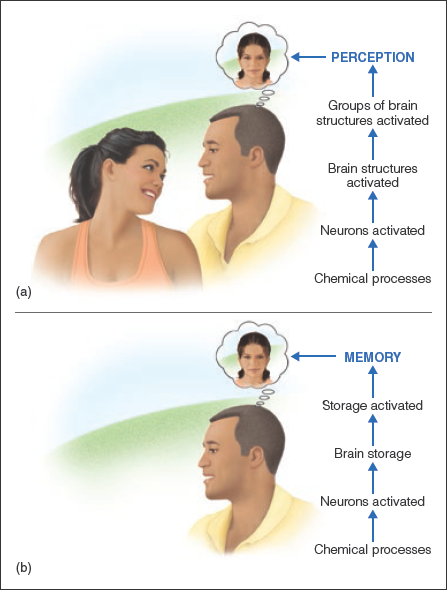
PERCEPTION: Chemical processes activate neurons, then brain structures, then groups of structures, resulting in the perception of Mary
MEMORY: Chemical processes activate neurons, leading to brain storage, which is later activated for the memory of Mary
Both processes demonstrate how understanding perception and memory involves examining physiological events at multiple levels, from chemical reactions to large-scale brain activity
NEURONS: BASIC PRINCIPLES
Brain appears to be static
NEURON(S): Cell that is specialized to receive and transmit information in the nervous system
EARLY CONCEPTIONS OF NEURONS
THE NERVE NET + GOLGI'S CONTRIBUTIONS
NERVE NET: A network of continuously interconnected nerve fibers (as contrasted with neural networks, in which fibers are connected by synapses)
In the 19th century, staining revealed a "nerve net" initially believed to be a continuous pathway for uninterrupted signal transmission, but early observation limitations made it appear continuous, obscuring the detailed structure
1870s: Camillo Golgi's (1843-1926) silver nitrate staining technique revolutionized brain research by selectively staining a small number of cells in their entirety, providing a much clearer view of individual neural structures compared to previous methods
CAJAL + THE NEURON DOCTRINE: INDIVIDUAL CELLS + NEURAL SIGNALING
NEURON DOCTRINE: The idea that individual cells called neurons transmit signals in the nervous system, and that these cells are not continuous with other cells as proposed by nerve net theory (States that individual cells transmit signals in the nervous system)
Spanish physiologist Ramon y Cajal (1852-1934) investigated the nerve net using two key techniques:
THE GOLGI STAIN: Selectively stained a small number of brain cells
STUDYING BRAIN TISSUE: He studied brain tissue from newborn animals, which has a lower cell density compared to adult brains
Methods showed the nerve net wasn't continuous ‒ the brain is made of connected neurons
Finding formed the basis of the neuron doctrine
NOTE: This contrasts with the nerve net theory, which proposed a continuous network of cells
Basically, Cajal revealed that the nerve net was not a continuous structure but rather composed of individual, connected units called neurons, a discovery that formed the basis of the neuron doctrine stating individual cells transmit nervous system signals, contrasting with the earlier nerve net theory
Cajal's made some additional conclusions about neurons:
There is a small gap between the axon of one neuron and the dendrites or cell body of another neuron ‒ gap is called a synapse
Neurons do not connect randomly but form specific connections with other neurons
These specific connections form groups of interconnected neurons, known as neural circuits
Beyond the brain, there are specialized neurons that gather information from the environment, such as those found in the eye, ear, and skin
Cajal's idea of individual neurons communicating via synapses to form neural circuits is considered foundational to understanding how the brain creates cognitions, making him "the person who made this cellular study of mental life possible"
BASIC PARTS OF A NEURON
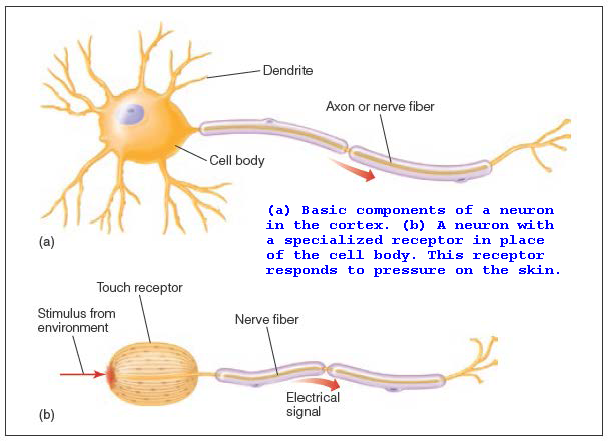
CELL BODY: Part of a cell that contains mechanisms that keep the cell alive. In some neurons, the cell body and the dendrites associated with it receive information from other neurons
Basically, it is the metabolic center of the neuron
DENDRITES: Structures that branch out from the cell body to receive electrical signals from other neurons
AXONS (NERVE FIBERS): Part of the neuron that transmits signals from the cell body to the synapse at the end of the axon
SYNAPSE: Beyond the brain, there are specialized neurons that gather information from the environment, such as those found in the eye, ear, and skin
NEURAL CIRCUITS: Group of interconnected neurons that are responsible for neural processing
RECEPTORS: Specialized neural structures that respond to environmental stimuli such as light, mechanical stimulation, or chemical stimuli
So, the neuron has a receiveing end and a transmitting end, and it's role is to transmit signals
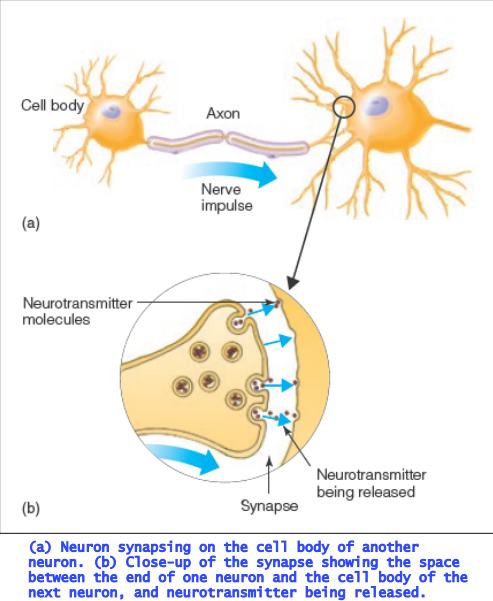
THE SIGNALS THAT TRAVEL in NEURONS
The exact nature of neuron signals required powerful amplifiers, developed in the 1920s
Edgar Adrian (1889-1977) used microelectrodes to record electrical signals from single sensory neurons, winning the 1932 Nobel Prize
This recording setup involves a microelectrode inside the neuron and a distant reference electrode
The charge difference is amplified and displayed, revealing the neuron's electrical activity
MICROELECTRODES: Small wires that are used to record electrical signals from single neurons.
RECORDING ELECTRODE: When used to study neural functioning, a very thin glass or metal probe that can pick up electrical signals from single neurons
REFERENCE ELECTRODE: Used in conjunction with a recording electrode to measure the difference in charge between the two. Reference electrodes are generally placed where the electrical signal remains constant, so any change in charge between the recording and reference electrodes reflects events happening near the tip of the recording electrode
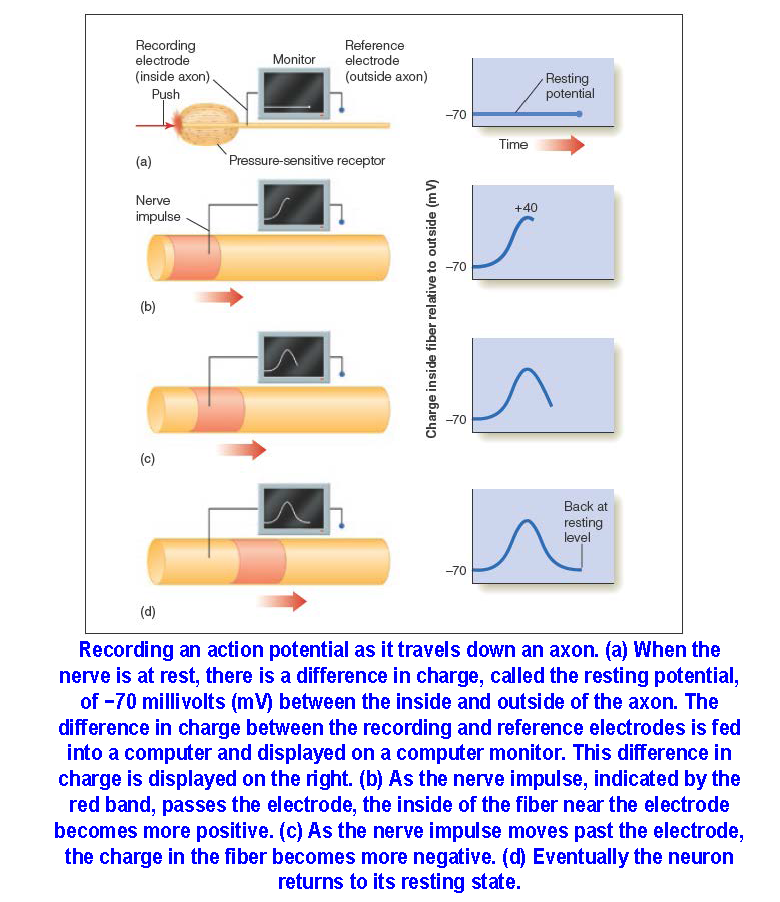
RESTING POTENTIAL: Difference in charge between the inside and outside of a nerve fiber when the fiber is at rest (no other electrical signals are present)
NERVE IMPULSE: An electrical response that is propagated down the length of an axon (nerve fiber) ‒ also know as a action potential
ACTION POTENTIAL: Propagated electrical potential responsible for transmitting neural information and for communication between neurons. Typically travel down a neuron’s axon
FROM NERVE NET to NEURON DOCTRINE
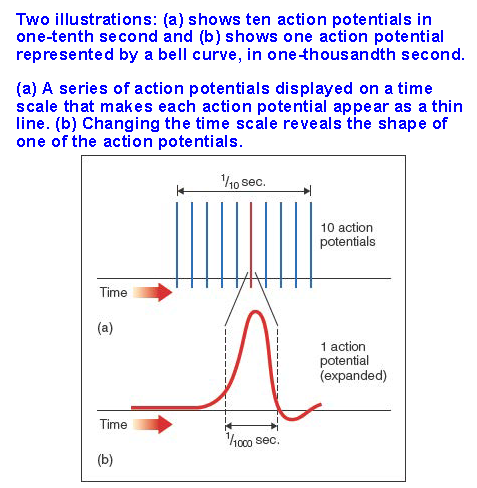
RESTING POTENTIAL
Axon at Rest: Potential difference = -70 mV (inside more negative than outside)
Maintained when no signals present
ACTION POTENTIAL (NERVE IMPULSE)
Stimulation of neuron receptor triggers impulse down axon
As impulse passes electrode: Inside charge rises to +40 mV (compared to outside)
Charge then reverses, becomes negative again
Returns to resting potential
Duration: ~1 millisecond
OBSERVATION
Multiple action potentials can travel past an electrode (represented by vertical lines on compressed time scale)
SIGNIFICANCE
Action potential is the primary mechanism for information transmission in the nervous system
Focus is on action potential, though other electrical signals exist